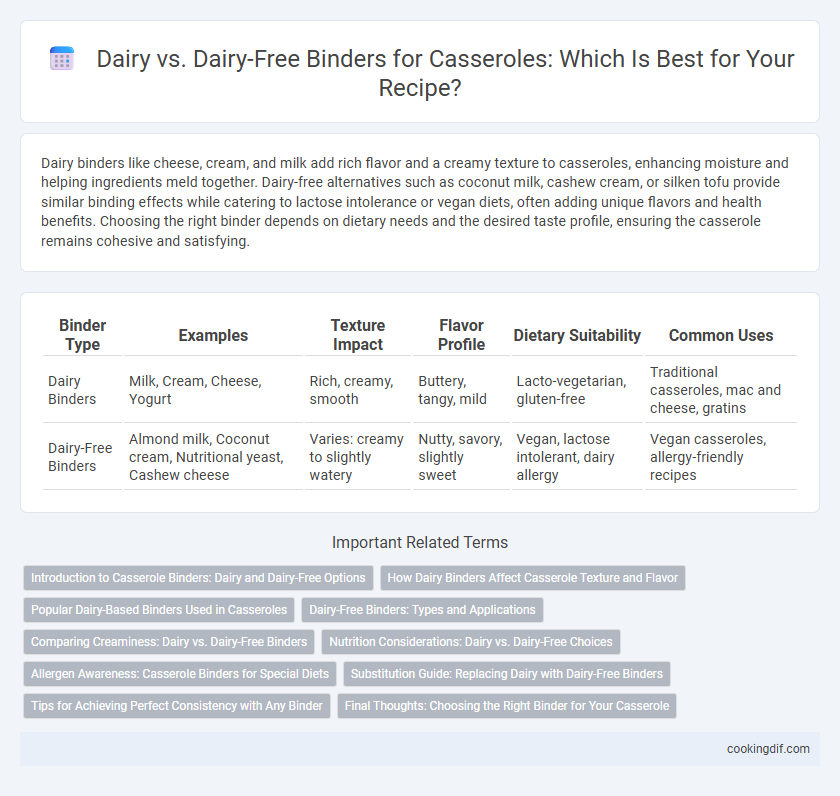Dairy binders like cheese, cream, and milk add rich flavor and a creamy texture to casseroles, enhancing moisture and helping ingredients meld together. Dairy-free alternatives such as coconut milk, cashew cream, or silken tofu provide similar binding effects while catering to lactose intolerance or vegan diets, often adding unique flavors and health benefits. Choosing the right binder depends on dietary needs and the desired taste profile, ensuring the casserole remains cohesive and satisfying.
Table of Comparison
| Binder Type | Examples | Texture Impact | Flavor Profile | Dietary Suitability | Common Uses |
|---|---|---|---|---|---|
| Dairy Binders | Milk, Cream, Cheese, Yogurt | Rich, creamy, smooth | Buttery, tangy, mild | Lacto-vegetarian, gluten-free | Traditional casseroles, mac and cheese, gratins |
| Dairy-Free Binders | Almond milk, Coconut cream, Nutritional yeast, Cashew cheese | Varies: creamy to slightly watery | Nutty, savory, slightly sweet | Vegan, lactose intolerant, dairy allergy | Vegan casseroles, allergy-friendly recipes |
Introduction to Casserole Binders: Dairy and Dairy-Free Options
Casserole binders play a crucial role in achieving the desired texture and consistency by holding ingredients together during baking. Dairy binders such as cream, cheese, and milk provide richness and a creamy mouthfeel, enhancing flavor and moisture retention. Dairy-free alternatives like coconut milk, cashew cream, and plant-based yogurt offer comparable binding properties while catering to lactose intolerance and vegan dietary preferences.
How Dairy Binders Affect Casserole Texture and Flavor
Dairy binders such as cheese, cream, and milk contribute richness, creaminess, and a smooth texture to casseroles by helping ingredients meld together while adding a savory depth that enhances overall flavor. Dairy-free binders, including coconut milk, cashew cream, and plant-based yogurts, provide varying consistencies and can introduce subtle nutty or tangy notes while maintaining moisture and cohesion in the dish. The choice between dairy and dairy-free binders significantly influences the casserole's mouthfeel and taste profile, with dairy options offering traditional creaminess and dairy-free alternatives catering to flavor diversity and dietary needs.
Popular Dairy-Based Binders Used in Casseroles
Popular dairy-based binders used in casseroles include heavy cream, sour cream, cheddar cheese, and cream cheese, which provide rich texture and creamy consistency. These ingredients contribute moisture and enhance flavor while helping to hold the casserole ingredients together during baking. Their fat content also aids in creating a smooth, cohesive dish that remains tender and satisfying.
Dairy-Free Binders: Types and Applications
Dairy-free binders for casseroles include ingredients like mashed potatoes, pureed vegetables, nut butters, and plant-based milks that provide moisture and cohesion without lactose. Aquafaba, flaxseed meal mixed with water, and arrowroot powder serve as effective emulsifiers and thickeners, enhancing texture and stability in vegan and allergen-free casseroles. These substitutes offer versatile applications in both savory and sweet casserole recipes, ensuring creamy consistency while catering to dairy intolerances and vegan diets.
Comparing Creaminess: Dairy vs. Dairy-Free Binders
Dairy binders like heavy cream and cheese provide rich, velvety creaminess that enhances casserole texture through natural fats and proteins. Dairy-free binders such as coconut milk, cashew cream, and almond milk offer creaminess with varied flavor profiles and lower saturated fat, often thickened with starches or nut purees for similar mouthfeel. Choosing between dairy and dairy-free binders depends on dietary needs and desired creaminess level, with dairy delivering classic lushness and dairy-free options catering to allergen-free or vegan preparations.
Nutrition Considerations: Dairy vs. Dairy-Free Choices
Dairy binders in casseroles provide essential nutrients like calcium, vitamin D, and protein, which contribute to bone health and muscle function. Dairy-free alternatives often rely on ingredients such as nut milks, coconut cream, or silken tofu, offering varied nutrient profiles with lower saturated fat and lactose-free benefits suitable for lactose-intolerant individuals. When selecting a binder, consider dietary restrictions and nutritional goals, as dairy options typically have higher calcium content, while dairy-free choices may include added vitamins and minerals to enhance nutritional value.
Allergen Awareness: Casserole Binders for Special Diets
Dairy binders in casseroles, such as cream, cheese, or milk, offer rich texture and flavor but can trigger allergies in individuals with lactose intolerance or milk protein sensitivities. Dairy-free alternatives like coconut milk, almond milk, or pureed vegetables provide safe, allergen-free options while maintaining moisture and cohesive texture in casseroles. Selecting the right binder is critical for accommodating special diets without sacrificing taste or consistency.
Substitution Guide: Replacing Dairy with Dairy-Free Binders
Dairy-free binders such as cashew cream, coconut milk, and silken tofu effectively replace traditional dairy in casseroles while maintaining a creamy texture and rich flavor. Nutrient-dense options like almond or oat milk combined with ground flaxseed or chia seeds form a stable, egg-free binder that suits vegan or lactose-intolerant diets. These substitutions ensure the casserole retains moisture and structure without compromising taste or nutrition.
Tips for Achieving Perfect Consistency with Any Binder
Choosing between dairy and dairy-free binders significantly impacts casserole texture and flavor; whole milk, cream, or cheese offer rich creaminess, while almond, coconut, or oat-based alternatives provide lighter, allergy-friendly options. Achieve perfect consistency by gradually mixing binders with flour or starch to prevent clumping and adjusting liquid ratios based on the binder's thickness. Cooking casseroles at moderate temperatures and allowing them to rest before serving ensures the binder sets evenly, delivering a smooth, cohesive dish every time.
Final Thoughts: Choosing the Right Binder for Your Casserole
Selecting the ideal binder for casseroles hinges on dietary preferences and texture goals; dairy binders like sour cream or cheese offer rich creaminess and depth of flavor, while dairy-free alternatives such as cashew cream, coconut milk, or plant-based yogurts provide similar moisture and binding without lactose. Understanding the impact of each binder on the casserole's consistency is crucial, as dairy options tend to thicken and brown more readily, whereas dairy-free choices can yield lighter, slightly different textures. Balancing taste, dietary needs, and textural expectations ensures a perfectly cohesive and flavorful casserole every time.
Dairy vs dairy-free binders for casseroles Infographic

 cookingdif.com
cookingdif.com